Release notes for the Genode OS Framework 19.02
In our road map for 2019, we stated our goal to make Genode more relevant and appealing for a broader community. The current release takes a big leap towards that goal: It opens up Sculpt OS for 3rd-party software providers, introduces a federated blogging platform about Genode-related topics, and makes the world's most popular programming language (Java) available to Genode users.
With the 4th stage of the evolution of Sculpt OS - themed as "community experience" (CE) - Genode's custom general-purpose OS introduces a novel and simple way for users to discover software, and for software providers to announce software. There is no middle man like an app store or a distribution! We hope that this federated model of software provisioning and deployment will have a vitalizing effect on the community around Genode. On a practical level, the interactivity of the new version is a playful and fun experience. Section Sculpt OS as a community experience (CE) gives a rough overview about Sculpt CE. A ready-to-use disk image will be released mid of March.
When speaking of "software providers", we don't think of anonymous repositories. Software - and Free Software in particular - is developed and provided by individuals after all. So in our federated way of software distribution, we want to highlight this individuality. For this reason, we launched a new blogging platform for Genode-related stories called Genodians.org, which gives everyone who is enthusiastic about Genode - users and developers alike - a platform to express ideas, announce software, or share practical tips and tricks. As explained in the initial posting, Genodians.org is - in the spirit of Sculpt's software distribution model - also organized in a federated way. The content is hosted and remains completely under control by the respective authors. The website merely aggregates and presents the content. It goes without saying that Genodians.org is based on Genode. The system image that contains the entire web appliance - from the kernel over the content management to the web server - is contained in a 8 MiB disk image. Section Genodians.org as a showcase of a Genode-based web appliance goes into more detail.
We identified the support of popular programming languages as one key aspect to attract a broader community. With the current release, our port of OpenJDK (Section Java) for both 64-bit x86 and 32-bit ARM has reached a mature state suitable for the creation of web services. This paves the way towards quite exciting new system creations, like the Boot2Java system presented in Section Showcase of a Java-based network appliance. On the account of programming-language support, we are happy to announce a vastly improved runtime support for Ada and SPARK (Section Ada and SPARK as well as the initial support for OCaml (Section OCaml).
Besides the work on shiny features, the current release cycle included a profound spring cleanup described in Section Base framework and OS-level infrastructure. It thereby finalizes the huge API modernization initiated almost three years ago.
Sculpt OS as a community experience (CE)
When we laid out the road map for Sculpt OS a little more than one year ago, we envisioned four stages of development. Sculpt EA was geared towards die-hard early adopters facilitating the live editing of the system using a text editor. Sculpt TC was targeted at "the curious" and included a graphical user interface for common administrative tasks. Sculpt VC introduced the visual composition of the system using an interactive graph. Even though Sculpt already allowed for the installation of components from different software providers at this stage, it offered no simple means to discover software and the installation still required the manual editing of "launcher" text files.
The final - community experience - stage of the plan ought to foster the federated provisioning of software. Software providers should have the ability to announce new packages. Conversely, users should be able to "subscribe" to such announcements, similar how one would subscribe to an RSS feed. Once software is discovered in this way, it should take only a few clicks to install and integrate it into the running Sculpt system. No command-line interface should stand in the way of discovery.
Sculpt CE is the realization of this idea.
For Sculpt users, the discovery starts at the + menu. In contrast to Sculpt VC where the menu offered a rather long list of components to choose from, the menu now offers nothing to be excited about.
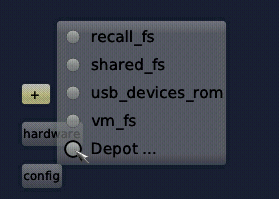
|
However, at the very bottom, there is a new menu entry "Depot ...", which leads to a sub menu with a list of enabled software providers. If connected to the network, it also shows an entry named "Selection ...".
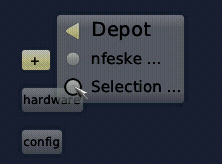
|
The "Selection" sub menu allows the user to enable software providers.
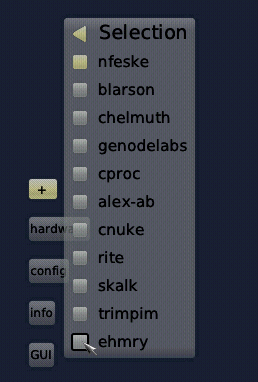
|
When clicking on one of the checkboxes, the package index of the provider is downloaded and the checkbox is highlighted. In the example, "nfeske" is already enabled.
By clicking on the top-left triangle, one can always go one menu up. Back in the depot menu, selecting a software provider will now display the index of available packages. When selecting a new package, it can be installed via a single click:
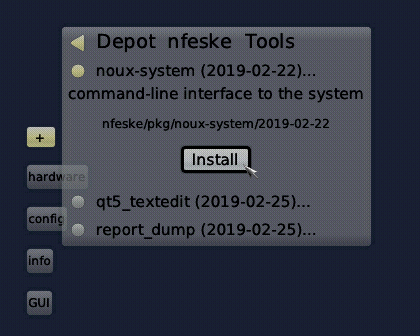
|
Once the package is installed, the menu takes the user to a dialog for integrating the package as a new component into the running Sculpt system. For each resource required by the package, the user can decide how to connect it. For example, the file system to be mounted at /config/ of a fresh noux-system instance can be routed to any file system service the user wishes. The noux-system won't know which file system is selected. It will just work with it.

|
As soon as all routes are defined, the dialog presents a button for adding the component to the system.
Using this interactive work flow, the discovery of software and its integration becomes a rather playful process.
To make a once composed system permanent, one can use the inspect window to copy the /config/managed/deploy file to the config/19.02/ directory of your Genode partition. This way, the deployment configuration will take effect immediately at boot time.
Genode 19.02 comes with Sculpt CE included. As usual, we will take a bit of time following the release for thorough testing and refining before announcing an updated disk image mid March. We would greatly appreciate your feedback during this phase! For baking a fresh Sculpt image, please refer to the documentation of Sculpt VC, but using the Git tag 19.02 instead of sculpt_vc.
Announcing software packages
The community experience of Sculpt CE will ultimately depend on the participation of software providers. To become listed in the selection dialog mentioned above, you may consider including your public key and download location at the Genode repository at /depot/.
For the announcement of packages, a software provider can publish so-called "index" files for a particular Sculpt version in the software provider's depot. E.g., the index of packages supported on Sculpt 19.02 would be located at index/19.02 within the depot. Like any other depot content, index files are digitally signed. An example index for the software provider "nfeske" would look as follows:
<index>
<index name="GUI">
<pkg path="nfeske/pkg/sticks_blue_backdrop/2019-02-22"
info="default desktop background"/>
<pkg path="nfeske/pkg/themed_wm/2019-02-26"
info="ready-to-use window manager"/>
</index>
<pkg path="nfeske/pkg/nano3d/2019-02-22"
info="simple software-rendering demo"/>
</index>
Each <pkg> node refers to a package with a concrete version and a short description. By nesting <index> nodes, software categories can be defined.
Index files can be published like any other depot content using the depot/publish tool, which takes care about compressing and digitally signing the published information:
./tool/depot/publish nfeske/index/19.02
To ease the updating of the index with current package versions, the sculpt.run script creates the depot/index/<version> file from the input found in repos/gems/run/sculpt/index. The latter file is void of any version numbers.
For any questions about the process, please consult the Genode mailing list.
Showcase of a Java-based network appliance
With OpenJDK in good shape (Section Java), we have created a Genode scenario that demonstrates JVM's ability to execute well on embedded hardware. As target platform, we choose an ARM (i.MX 6) based SoC with two integrated network interface controllers. In the scenario, the Genode system boots directly into a Java application, which in turn spawns two HTTP server instances where each instance communicates through a dedicated NIC. Both server instances run as one Java program.
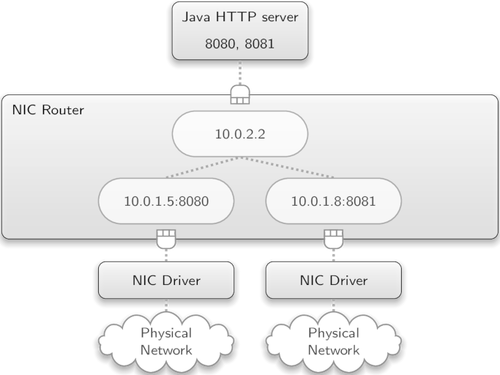
|
The Java application (a JAR file) is loaded from the board's SD card, and therefore, can easily be replaced. If you are interested in Java and ARM SoC, the full details and a step by step instruction can be found at our Genodians.org site.
Genodians.org as a showcase of a Genode-based web appliance
Genodians.org is our take on a federated blogging platform about Genode-related topics. It does not host the actual content but rather aggregates content hosted elsewhere.
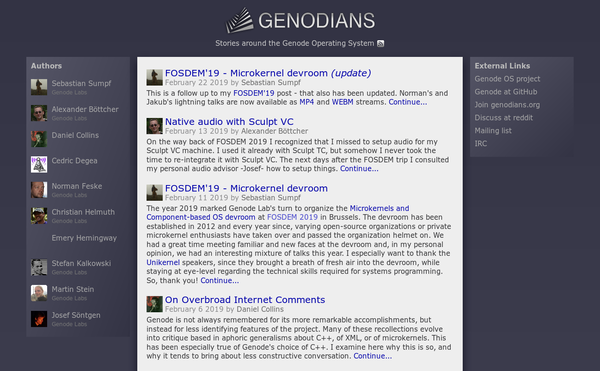
|
The site periodically fetches content in the form of zip archives containing raw text and PNG images, extracts the archives, and transforms the text into HTML using a custom static site generator. The result of the transformation process is served by the lighttpd web server.
This system is based on Genode and can be found here:
- Genodians.org repository
A few noteworthy technical points about the site:
-
The periodic process of downloading, extracting, and transforming content is realized via the fetchurl, extract, and sequence components.
-
The textual content uses the markup of the GOSH text processing tool, which is similar to Markdown.
-
The custom static site generator consists of a plain makefile and a few GOSH style files. The makefile is executed within a noux instance, which is Genode's custom Unix runtime environment. It is re-spawned for each iteration. As GOSH is written in Tcl, the tclsh is used within the noux environment.
-
The lighttpd web server uses a statically supplied SSL certificate.
-
The most time-consuming part of creating Genodians.org was the CSS definition.
-
The entire system image is about 8 MiB in size. It includes the following ingredients:
-
Kernel (e.g., NOVA),
-
Basic Genode components such as init, NIC router, the VFS server,
-
Network driver (based on iPXE),
-
Linux TCP/IP stack as a library,
-
Curl, libssh, libssl, libcrypto, lighttpd (for downloading and serving content),
-
libarchive, zlib, liblzma (for extracting the downloaded content)
-
Noux, coreutils (stripped down), bash, GNU make, and tclsh (for transforming text into HTML)
-
More information about the site's inner working will be posted in a series of articles - guess where? - at Genodians.org!
Base framework and OS-level infrastructure
Removal of deprecated APIs
Almost three years ago - with version 16.05 - we started the transition to Genode's modern API. One year later - in version 17.05, we announced the completion of this transition but we retained the deprecated APIs to accommodate Genode users that picked up the new API only gradually. With the current release, we finally drop the deprecated APIs along with a couple of other legacies:
-
The base/timed_semaphore.h has been removed. In hindsight, officially providing this utility was a big mistake because it lured developers into a wrong direction. In fact, we found that there is no legitimate use of it when a component is designed in a clean way. If a component relies on a timed semaphore, it should better be redesigned. There are two noteworthy places where a timed semaphore is still used as a band-aid solution: the pthread_cond_wait implementation of the libc, and DDE for rump kernels. Those places now host a private copy of the timed semaphore, but should ultimately be reworked.
-
The header base/printf.h has been removed along with the log back end for printf. The Console with the format-string parser is still there along with snprintf.h because the latter is still used at a few places, most prominently the Connection classes.
-
The notion of a Ram_session exists no more since the former RAM-session interface was merged into the PD-session interface in version 16.05. Still, the types were preserved (by typedefs to Pd_session) to keep up API compatibility. Those last traces of Ram_session are gone now. The Env::ram() accessor returns the Ram_allocator interface, which is a subset of the Pd_session interface.
-
The use of the global Genode::env() accessor function is not possible anymore.
-
The old Child_policy::resolve_session_request interface that returned a Service instead of a Route has been removed.
-
Boolean accessor methods are no longer prefixed with is_. E.g., instead of is_valid(), use valid().
-
All connection constructors need the Env as argument.
-
The Reporter constructor needs an Env argument now because the reporter creates a report connection.
-
The old notion of Signal_dispatcher is gone. For receiving asynchronous notifications, the Signal_handler interface must be used.
-
Transitional headers like os/server.h, cap_session/, volatile_object.h, os/attached*_dataspace.h, and signal_rpc_dispatcher.h have been removed.
-
The distinction between Thread_state and Thread_state_base does not exist anymore. Only Thread_state prevails.
-
The header cpu_thread/capability.h along with the type definition of Cpu_thread_capability has been removed. Use the type Thread_capability defined in cpu_session/cpu_session.h instead.
-
The os/ram_session_guard.h has been removed. Use Constrained_ram_allocator provided by base/ram_allocator.h instead.
Source-tree reorganization
Timer moved from os to base repository
Traditionally, the user-level timer was hosted at the os repository at drivers/timer/. However, since the timer and timeout handling have become part of the base library (the dynamic linker), the component naturally belongs to the base repository. It is now located at base/src/timer/ and base-<kernel>/src/timer/ respectively.
Note that this change affects include paths for the former include/os/timer/, include/os/alarm.h, and include/os/duration.h headers. Those can now be found in include/base/.
Consistent naming of block components
Regarding the naming of files and APIs, Genode follows the convention of avoiding abbreviations. Most components follow this convention, with the block servers being the exception to the rule. Those were named "part_blk" or "rom_blk". With the current release, we removed this inconsistency by renaming those offenders, changing "blk" to "block". Closely related, abbreviations like "cli" and "srv" have been replaced by "client" and "server".
Improved API safety
XML-parsing API
Genode consistently uses XML for component configurations and for reports generated by components. The latter are often consumed by other components. This puts the XML parser into a prominent position. Genode's XML parser comes in the form of the Xml_node class. Since it was introduced before the age of modern C++, it offers several risky "C-ish" methods, in particular accessors that return pointers, raising memory-safety concerns. To promote a safe programming style, the following parts of the interface are subject to change now:
-
The Xml_node::addr, Xml_node::content_addr, and Xml_node::content_base accessors will be removed because it is all too easy to store the returned pointers and forget about the lifetime of the originating Xml_node object.
Fortunately, in practice, those methods are rarely used because information is typically represented in attributes, not as node content. However, to still support the access to the raw content, the new Xml_node::with_raw_node, Xml_node::with_raw_content, and Xml_attribute::with_raw_value methods call a functor taking the raw byte buffer and size as arguments. This way, the lifetime of the pointer is naturally bound to the scope of the functor.
-
The new with_sub_node method calls a functor with the specified sub node as argument and thereby reduces the need for the traditional Xml_node::sub_node method, which returns an Xml_node. The latter is risky because an Xml_node contains a pointer to the actual data. In contrast, the lifetime of the Xml_node processed via the new Xml_node::with_sub_node is naturally bound to the scope of the passed functor.
-
The Xml_attribute::value and Xml_node::value methods now take an argument of type T &out instead of T *out, which eliminates the uncertainty of a possible nullptr argument.
The original interface will still be available for a while but it will eventually be removed.
Simplified session-policy handling
Most server components make use of the Session_policy utility for selecting a client policy depending on the session label. However, the pattern of its use remained a bit inconsistent across components, in particular the handling of the case where no policy could be found. Some components outright denied the session where others implemented a fallback to a built-in default policy. This inconsistency is now removed.
Following the principle of deny-by-default the absence of a matching policy denies the session request. Since the Session_policy::No_policy_defined exception is a typedef to the Genode::Service_denied exception, a server does not need to explicitly handle it, which simplifies the implementation. With this change, the No_policy_defined case is always an error case. Hence, the new version of Session_policy prints a error message, which relieves the server developer from implementing diagnostics in the server code.
As a consequence of this change, scenarios that used to rely on the policy-fallback approach of some servers - notably the NIC bridge, window manager, the window decorators - need a slight adaption: To enable the fallback to a default policy, a <default-policy> node must be explicitly specified in the server's configuration.
Removed pointers from Genode::Fifo interface
To make the use of the Genode::Fifo data structure more safe, all methods that return pointers have been replaced by methods that call a functor with a reference as argument.
New server-side block-request stream API
The current block-component API (os/include/block/) was designed at a time long before Genode's modern component API was introduced. Back then, the use of blocking calls was prevalent. Today, we design components to work asynchronously. The original block-server API was successively enhanced to allow the implementation of asynchronous block servers but it remained "upside down" while growing more complicated than it should be.
To simplify the implementation and verification of block servers, the current release introduces a modern API that will eventually replace the original block-component API. The new API is called block-request stream and can be found at os/include/block/request_stream.h. It is designed with the following considerations:
-
It anticipates the asynchronous operation of block servers by default. Using the new API, such servers - in particular block-device drivers - can be implemented as state machines triggered by client requests and device interrupts.
-
It reinforces the memory safety of the server code by not returning any pointers or references.
-
It relieves the server developers from handling special cases (like a congested acknowledgement queue) while being flexible enough to accommodate different categories of components like drivers, resource multiplexers (part_block), and bump-in-the-wire components in a natural way.
-
It naturally supports the batching of requests as well as zero-copy (device DMA directly into the client's communication buffer).
The use of the new API is illustrated by the artificial test at os/src/test/block_request_stream/. We plan to successively migrate all existing block servers to this new API and will remove the traditional block-component API eventually.
GUI stack
Motivated by our work on Sculpt as described in Section Sculpt OS as a community experience (CE), Genode's GUI stack received the following improvements:
Window management
To improve the visual appearance of Sculpt's administrative GUI, the themed decorator was enhanced with an option to disable decorations based on the window label. By setting the decoration attribute of a <policy> node to "no", matching windows appear without any border, which is desirable for Sculpt's component graph.
Furthermore, the themed decorator accepts the <policy> attribute motion=<number>. The default value is 0. If a value higher than 0 is specified, window-geometry changes are applied as an animation where the
<number> denotes the number of animation steps. This feature is used for smoothing the placement of Sculpt's component graph.
The motif decorator - which is a nice alternative to the themed decorator - is now giving visual feedback to mouse clicks. For example, while the user drags a window by clicking on the window title, the title bar appears as pressed, which creates an improved sense of responsiveness.
Unified shape-report routing
Applications propagate custom mouse-cursor shapes by issuing "shape" reports towards the pointer component. The pointer component correlates the session labels of the incoming shape reports with the label of nitpicker's currently hovered client. Hence, an application's shape report session should take the same route as its nitpicker session.
The presence of the window manager as an intermediary of the nitpicker session breaks this rule. Consequently, rather awkward label-rewriting magic was required when routing shape reports originating from windowed applications. To make the shape reporting more natural, the window manager has become able to proxy shape reports on behalf of its clients. When routing a shape through the window manager, the labels of both the nitpicker sessions as well as the shape report sessions contain the intermediary "wm ->" part.
Unicode support for the graphical terminal
The terminal has been changed to represent characters as 16-bit codepoints internally. It thereby became able to display a much larger variety of international characters when using a suitable font. Unicodes are sent through the terminal session via bursts of UTF-8 bytes now.
As a collateral change, the generic Codepoint class became printable via Genode's Output interface. This way, a codepoint can easily be serialized into UTF-8 bytes.
Programming languages
Ada and SPARK
The work described within this section was contributed by Componolit. Thanks to Alexander Senier and Johannes Kliemann for the fantastic collaboration!
The integration of SPARK/Ada programs was improved greatly and the Ada runtime was renamed to spark. This emphasizes its main purpose: trusted components that can be formally verified. A more feature-rich runtime based on libc was added to genode-world under the name ada.
Build system integration
Up until now, the (deprecated) gnatmake tool was used to build Ada object files. This was unfavorable for two reasons: First, multiple invocations of gnatmake would sporadically corrupt the compiler-generated Ada linker files (.ali) and break parallel builds. Second, Ada dependency information did not get propagated into Genode's build system such that certain source changes failed to trigger a rebuild.
For these reasons the gnatmake tool has been dropped in favor of regular compiler calls as done for all other languages. To facilitate consistent rebuilds on source-code changes, the ali2dep tool was created. From an .ali file, it produces .d files suitable for direct inclusion into Genode's build system.
Until the integration into the toolchain, ali2dep support needs to be enabled through the CUSTOM_ALI2DEP variable (absolute path or command name if the command is in PATH). By default, a warning about the absence of the tool is emitted and dependency information is not generated. You can add this variable to the etc/tools.conf of your build directory as follows:
CUSTOM_ALI2DEP = /path/to/ali2dep
Elaboration code
Previously, Ada programs that required elaboration code to be run were unsupported on Genode. With this release, Ada programs are bound using gnatbind, which results in elaboration code being generated. An additional benefit comes in the form of proper error messages at compile time if, for example, source code is missing or outdated.
To run an Ada main program with elaboration, calls to adainit() and adafinal(), generated by the binder, need to be added to your component-construction code:
extern "C" void _ada_main(void);
extern "C" void adainit();
extern "C" void adafinal();
void Component::construct(Genode::Env &env)
{
adainit();
_ada_main();
adafinal();
env.parent().exit(0);
}
Note, that the name of the Ada main program (_ada_main()) in this example depends on the name of your main procedure.
Debug output
Support for GNAT.IO was added to the runtime. GNAT.IO is a stripped-down text I/O facility, which we map to a terminal session on Genode. Only output is supported at the moment. A pointer to a terminal session has to be provided to the ADA runtime in order to use GNAT.IO. Please refer to repos/libports/src/test/gnatio/ as an example.
Unit testing
To facilitate test-driven development of Ada components, the AUnit unit testing framework was ported to Genode. It is located in the genode-world repository whereas a usage example can be found at src/test/aunit. Note that the full Ada runtime (ada) is required as the framework uses features not present in the SPARK runtime.
Java
Since Genode release 18.11, we continued our effort to enable the just-in-time (JIT) compiler for OpenJDK. We are happy to announce that we were able to achieve this goal. The JIT compiler is now enabled as default for both x86 (64 bit) and ARM (32 bit), which significantly improves the performance of the Java virtual machine for these architectures.
Additionally, we even further improved JVM's performance by taking advantage of more aggressive compiler optimizations. This triggered some unidentified bugs and led to a greatly enhanced stability of OpenJDK.
For a small hello world example we offer a simple run script:
make run/java
For a more complex scenario please refer to Section Showcase of a Java-based network appliance.
Nim
Support for Nim has been removed from the Genode build system to encourage building Nim components out-of-tree using the Nimble package manager. The compatibility of the base system with the Nim runtime will be monitored and improved regardless of this change.
OCaml
A proof-of-concept port of the OCaml bytecode interpreter has been placed in the world repository. This allows simple programs that are compiled to the bytecode instructions to be executed and is a first step in supporting the OCaml language. This interpreter does not yet include the standard library. Therefore only language primitives are available. Porting the standard library appears to simply be a matter of defining a build process. The greatest hurdle to porting existing OCaml applications would seem to be finding a path into the workflow of the OPAM package tooling.
Libraries and applications
New utility for taking screenshots
The flif_caputure screenshot utility has been added to the world repository. This utility implements a framebuffer and input service which it proxies to its parent. When the utility observes the PrtSc key, it captures the content of the framebuffer and writes it to the file system in the FLIF image format, FLIF being chosen primarily for its uncomplicated API. To use the utility in practice, the common case would be to run it as a client of the default window manager with a second window manager stack running as a client of the capture utility. This allows capture behavior and scope to remain simple and explicit.
The background story behind the tool is covered by a dedicated posting at Genodians.org.
Growing use of the Genode-World repository
The Genode-World repository contains software that is not strictly part of the official Genode OS framework but rather supplemental. In particular, it contains ports of 3rd-party software to Genode. The pool of ported software is steadily growing, which moves the world repository more and more into the spotlight of Genode users. For example, among a variety of games and experimental components, our port of OpenJDK (Java) is also hosted there. To acknowledge the growing importance of the world repository, we added the building of all world depot archives to our nightly build tests.
With this baseline of quality assurance in place, it was a good time to move supplemental software such as Dosbox, FUSE, libav, libSDL, and its companion libraries from the Genode repository to the Genode-World repository. Speaking of libSDL, as part of the curation of the world content, the library back end of libSDL has been changed to the direct use of the nitpicker session interface instead of the lower-level framebuffer and input interfaces. Thanks to this change, many scenarios could be greatly simplified, in particular packages designated for the use in Sculpt OS.
Updated or removed 3rd-party software
The following 3rd-party software received an update:
-
OpenSSL updated to version 1.0.2q with SSL_CONF_* enabled, as needed by lighttpd's mod_openssl.
-
Lighttpd updated to version 1.4.52, with TLS enabled.
-
libpng updated to version 1.6.36
-
jbig2dec updated to version 0.15
Removal of VirtualBox 4
All regular users of Genode's VirtualBox port migrated to version 5 a long time ago. Version 4 was still maintained because this is the only version supported on the Muen separation kernel. However, since the focus of the Muen developers recently moved towards the use of nested virtualization, our version of VirtualBox 4 is no longer vital for Muen. So we could remove it.
Platforms
Board support for i.MX6 Quad Sabrelite and Nitrogen6 SoloX
In 2018, we extended our device-driver support for NXP i.MX 5 and 6 based ARM platforms. This year, we continue our commitment to this platform with additional support for the NXP reference board i.MX6 Quad Sabrelite and the Nitrogen6 SoloX, which features dual Gigabit Ethernet.
Resizeable virtual framebuffer on Linux
When executing Genode on Linux, we use a libSDL-based pseudo driver for running graphical scenarios. This fb_sdl server has now been enhanced with the ability to resize the SDL window. Such a resize event is translated into Genode's framebuffer resize protocol. Thereby, the resizing of the host window looks like a mode change to Genode's GUI stack. This greatly eases the testing of the mode-change handling of components like the nitpicker GUI server.
Tooling and build system
Enforced override annotations
The -Wsuggest-override warning complains about implementations of virtual functions that lack the override keyword. If the implementation of a virtual method is marked as override the compiler checks for a matching virtual method in the base class. If there is no such method, the implementation unexpectedly diverged from the interface.
An interface may change over time, which is especially troublesome when it contains a default implementation of a virtual method. Without override annotations, the compiler will silently add the outdated implementation of the derived class as an overload of the interface's default implementation, which introduces a subtle but potentially serious bug.
To rule out such bugs in the future, we made override annotations mandatory when using the default strict warning level.
Generalized use of the depot by run scripts
With more and more run scripts using archives out of Genode's depot, we gained experience with typical usage patterns. In particular, we found the universal use of the configurable depot user preferable over the hard-wiring of genodelabs. Hence the depot_user function has become a built-in function of the run tool.
Repeat mode for the depot-autopilot test environment
The depot_autopilot.run script now supports the environment variable TEST_REPEAT with the possible values until_forever and until_failed. When specified, the tests are run in a loop. The latter argument is particularly useful for reproducing sporadic errors.
New run script to execute a single test w/o the depot
The new os/run/test.run script allows for the quick execution of an individual test from the build directory while side-stepping the depot. It expects a PKG variable specifying the test package. E.g.,
make run/test KERNEL=nova PKG=test-xml_node
Note that it does not cover all test packages right now. The tool and its limitations are explained in more detail by a dedicated posting at Genodians.org.
Support for undefined-behavior sanitizer
The UndefinedBehaviorSanitizer (UBSan), also described in the GCC documentation, can detect undefined behavior while a program is running.
With the current release, this diagnostic feature of GCC becomes available for analyzing Genode components. By specifying SANITIZE_UNDEFINED = yes in a target.mk file, the -fsanitize=undefined compiler flag is enabled and the program is linked with libubsan and libsanitizer_common. The program has to call env.exec_static_constructors() and sanitizer_init(env) upon startup to initialize the sanitizer libraries. Whenever undefined behavior is detected while the program is running, a "runtime error:" message including the source code location of the error is printed to the log.
